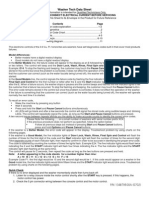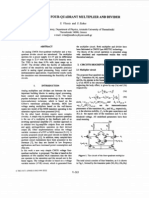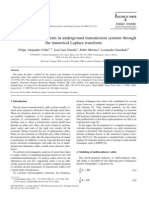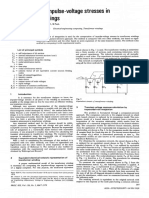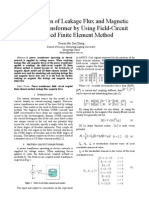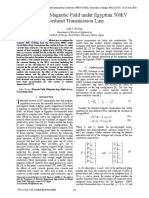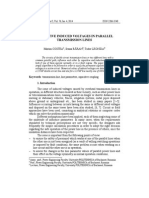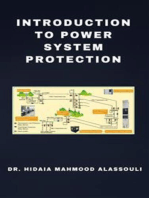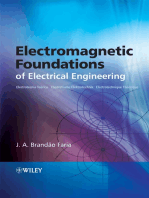A Computer Model For Transient Voltages Distribution Studies in Transformer Windings
A Computer Model For Transient Voltages Distribution Studies in Transformer Windings
Uploaded by
learningalotCopyright:
Available Formats
A Computer Model For Transient Voltages Distribution Studies in Transformer Windings
A Computer Model For Transient Voltages Distribution Studies in Transformer Windings
Uploaded by
learningalotOriginal Title
Copyright
Available Formats
Share this document
Did you find this document useful?
Is this content inappropriate?
Copyright:
Available Formats
A Computer Model For Transient Voltages Distribution Studies in Transformer Windings
A Computer Model For Transient Voltages Distribution Studies in Transformer Windings
Uploaded by
learningalotCopyright:
Available Formats
Proceedings of the 9th WSEAS/IASME International Conference on ELECTRIC POWER SYSTEMS, HIGH VOLTAGES, ELECTRIC MACHINES
A Computer Model for Transient Voltages Distribution Studies in
Transformer Windings
V. VENEGAS, J.L. GUARDADO, E. MELGOZA, S. MAXIMOV, M. HERNANDEZ
Department of Electrical Engineering
Instituto Tecnológico de Morelia
Av. Tecnológico 1500, Col. Lomas de Santiaguito, C.P. 58120
MORELIA, MEXICO
vvenegasr@yahoo.com
Abstract:- In this work, a computer model for calculating surge distribution in power transformer windings is
presented. The model is based on multiconductor transmission line theory, considering each disk coil as the basic
element for the analysis. The electric parameters R, L, C and G are calculated by using conventional formulations.
The electrical parameters are used for calculating modal parameters in order to represent the winding as a two port
network. The transformer model is validated by means of a comparison between measured and calculated transient
voltages in a phase winding with 34 coil disks, in a scaled down prototype of a power transformer.
Key-Words:- Electrical parameters, modal parameters, fast transients, transformer windings.
1 Introduction the distributed parameters of the winding in an easy way
The transformer is one of the most important and [2,6].
expensive equipment in modern power systems. This The aim of this work is to develop a transformer
has motivated the development of several studies in model in the frequency domain for calculating surge
order to understand its performance, specially during distribution in the power transformer windings. The
switching transients and lightning, which can lead to model is based on the fact that turns and disks run
different kinds of failures [1,2,3]. The Mexican Utility parallel to each other in the winding. Therefore the
(CFE) reports that 53% of power transformers failures computer model developed is based on multiconductor
occur in the insulation system and a significant amount transmission line theory and modal analysis which
is due to the presence of electromagnetic transients [3]. consider the coils as the basic element for the analysis.
Transient overvoltages produce high dielectric The computer model developed takes into account the
stresses that can damage the turn insulation and which frequency dependence of the electrical parameters. The
can lead to more severe failures like short circuit transient voltages calculated in the turns and coils of a
between turns, layers or disks inside the transformer [3]. phase winding are compared with laboratory
The surges waveforms have two characteristics that can measurements in a scaled down prototype of a 115 kV
be dangerous for the insulation winding: short rate of transformer winding. The phase winding used in this
rise and high amplitude. Typical rates of rise are in the study is shown in Figure 1.
order of 10 to 20 ns and the amplitudes are in order of
1.5-2.5 p.u. [2]. Short rates of rise are responsible for a
nonlinear voltage distribution inside the winding, which
may lead to failures in winding sections near to
transformer terminals.
Several computer models have been proposed in the
literature for studying electromagnetic transients in
transformers. A great number of models are based on
equivalent lumped circuits with coupled inductances and
capacitances [4,5]. Some models have been developed
using transmission line theory, which has the advantage
of including the frequency dependent phenomena and
Fig. 1 Scaled down prototype of a 115 kV transformer.
ISSN: 1790-5117 121 ISBN: 978-960-474-130-4
Proceedings of the 9th WSEAS/IASME International Conference on ELECTRIC POWER SYSTEMS, HIGH VOLTAGES, ELECTRIC MACHINES
2 Model Description where A, B, C y D are the modal matrices of the
The frequency domain transformer winding model is winding given by:
developed using multiconductor transmission line
theory. The propagation of voltages and currents along a A = D = Y0 coth ( ZY l ) (4)
transmission line is given by: B = C = Y0 cosch ( ZY l ) (5)
2
d V = Z Y V = PV (1) The following voltage and current relations can be
dx 2 established from Fig. 2 [6]:
2
d I (2)
= Y Z I = PT I
dx 2 I r1 = − I s 2 I r 2 = − I s3 Vr 1 = V s 2
Vr 2 = Vs 3 − I r 3 = Vr 3 / Z r (6)
where:
V, I .- Voltage and current vectors.
Z .- Series impedance matrix. By substitution of equations (6) in (3) and after some
Y .- Parallel admittance matrix. matrix operations, the terminal voltages and currents are
P .- Product of matrices Z and Y. given by [6,7]:
PT .- Product of matrices Y and Z.
⎡ I s1 ⎤ ⎡ ⎤ ⎡Vs1 ⎤
For developing the model a single coil is considered ⎢ ⎥ ⎢ ⎥ ⎢ ⎥
⎢Vs 2 ⎥ = ⎢ M ⎥ ⎢0 ⎥ (7)
as the basic element for the analysis. Fig. 1 shows a ⎢Vs 3 ⎥ ⎢ ⎥ ⎢0 ⎥
transformer winding section with three coils in a series ⎢ ⎥ ⎢ ⎥ ⎢ ⎥
connection. In Fig.2, Zr is the impedance that can be ⎣⎢Vr 3 ⎦⎥ ⎣ ⎦ ⎣0 ⎦
used to represent the remaining turns and coil disks in
the winding. Vs1 is the voltage surge applied at the Equation (7) is used for calculating the surge
beginning of the winding. distribution inside the winding just by multiplying the
applied surge, Vs1, by the first column of the system
matrix M. The transient overvoltages are transformed to
the time domain by means of the Modified Fourier
Transform Algorithm.
3 Electrical Parameters Calculation
For calculating the modal parameters and develop the
computer model, the matrices Z and Y are required.
These can be calculated by the general formulations:
Z=R+ jωL (8)
Fig. 2 Winding model with coils in a series connection. Y =G + j ωC (9)
From modal analysis, the terminal conditions of the where R, L, G y C are de resistance, inductance,
winding model are given by: conductance and capacitance matrices, respectively. Due
to the assumption of considering each disk coil as a
⎡ I s1 ⎤ ⎡Vs1 ⎤ basic element of analysis, the matrices of parameters
⎢ ⎥ ⎢ ⎥ are of order n x n, where n is the number of coils in the
⎢ I s 2 ⎥ ⎡ A − B ⎤ ⎢Vs 2 ⎥ winding. Self and mutual and electric and magnetic
⎢I s3 ⎥ ⎢ ⎥ ⎢V ⎥
⎢ ⎥=⎢ ⎥ ⎢ s3 ⎥ (3) effects are taking into account for each disk as well as
⎢ I r1 ⎥ ⎢ ⎥ ⎢Vr1 ⎥ with other coils in the winding.
⎢I ⎥ − C ⎢ ⎥
D ⎦ ⎢Vr 2 ⎥ In the transformer, there are several capacitances
⎢ r2 ⎥ ⎣ ⎢ ⎥
⎢⎣ I r 3 ⎥⎦ ⎢⎣Vr 3 ⎥⎦ distributed along the turns, coil disks and between the
high voltage and low voltage winding. The calculation
ISSN: 1790-5117 122 ISBN: 978-960-474-130-4
Proceedings of the 9th WSEAS/IASME International Conference on ELECTRIC POWER SYSTEMS, HIGH VOLTAGES, ELECTRIC MACHINES
of the capacitance depends upon the geometric and
electric characteristics of the coil winding. The
capacitances between a coil in the high voltage winding NCore
ú c le o
and the low voltage winding is calculated by considering
a configuration of concentric cylinders by means of [8]: C ev
Cn
2πε 0 ε r l v (10)
C db
C db = L.V
C day
⎛r ⎞
ln⎜⎜ 2 ⎟⎟ DWinding
evanado
d e B a ja
⎝ r1 ⎠ T e n sió n
C day
where εr is the permitivity of the insulation and the two
radius are shown in Fig. 3.
D evanado de
The capacitance between turns in the same disk and H.V. Winding
A lta T e n s ió n
between turns located in different disks is calculated by
using a parallel plate approach, then [4,6]: Fig. 4 Coils and turns under study.
ε0ε r A For calculating inductance let us consider Fig. 5.
C= (11)
d This figure shows two winding turns at different coils.
where εr is the relative permitivity of the insulation, A is
the area of the winding section involved and d is the
distance between both surfaces. These capacitances are
Espira
Turn A A
used for calculating the total capacitance of one disk and a
between adjacent coils in the same phase winding. Fig. 4
shows the transformer turns and disks with some of the d
capacitances considered in the model.
Once the capacitance is calculated, the conductance
Turn B B
Espira
matrix is obtained with [6]: b
G = ω C tan δ (12) Fig 5. Representation of turns for inductance calculation.
where tan δ is the loss tangent of the turn insulation. The self inductance of one coil disk is calculated
with [8]:
⎛ 8 Rm ⎞
Li = µ 0 Rm NB 2 ⎜ ln − 2⎟ (13)
r2 ⎝ GMD ⎠
Cdb
Core
Núcleo where Rm is the radius of the mean turn of the disk, NB
Core Cn is the number of turns, w and h are the dimensions of the
Núcleo
r1 turn conductor with a rectangular transversal section and
GMD is the geometrical mean radius given by:
L. V. Winding GMD 2h w 2w h
Devanado de Baja Tensión ln = tan −1 + tan −1
(w 2
+h 2
) 3w h 3h w
(14)
H. V. Winding
Devanado de Alta Tensión
h2 ⎛ w2 ⎞ w2 ⎛ h 2 ⎞ 25
− 2
ln ⎜⎜1 + 2 ⎟⎟ − 2
ln ⎜⎜1 + 2 ⎟⎟ −
12 w ⎝ h ⎠ 12 h ⎝ w ⎠ 12
Fig. 3 Configuration for calculating capacitances between L.V. winding
and H.V. winding.
The mutual inductance between the different turns is
calculated with [4]:
ISSN: 1790-5117 123 ISBN: 978-960-474-130-4
Proceedings of the 9th WSEAS/IASME International Conference on ELECTRIC POWER SYSTEMS, HIGH VOLTAGES, ELECTRIC MACHINES
⎡⎛ 2 ⎞ 2 ⎤
L12 = µ 0 ab ⎢⎜ − k ⎟ K (k ) − E (k )⎥ (15)
⎣⎝ k ⎠ k ⎦
Where
4ab (16)
k=
(a + b )2 + d 2
K(k) .- elliptic integral of the first kind.
E(k) .- elliptic integral of the second kind.
The frequency dependent resistance for each turn is
calculated by using [9]:
l
Rskin = (17) Fig 6 Experimental arrangement to make measurements
aδσ
From figures 7 and 8 it is clear that the computer
where σ is the conductivity, l the turn length and a the model is capable of calculating the transient voltages
perimeter of the transversal section of one turn. The with a reasonable degree of accuracy. In general, there
term δ is the magnetic flux penetration into conductor exist good correlation on the shape and magnitude of the
regions due to skin effect, which is given by: surge distribution calculated and measured. This gives
confidence in the assumptions made for developing the
2 distributed parameter model.
δ= (18)
ωσµ The results show that the surge propagation inside the
winding is similar to traveling waves in overhead
transmission lines. The applied pulse penetrates into the
The total resistance of one coil is the sum of the coil where it is attenuated, distorted and reflected until
resistances of its turns its arrival to the remote end. For short circuit conditions
the magnitude of the pulse is reduced after traveling
from coil to coil (Voltage equal to zero at the remote
4 Results end). On the other hand, for open circuit conditions the
In order to validate the computer model, a peak magnitude is increased gradually as the surge
comparison between the transient voltages calculated voltage travels inside the winding until it reaches the
and measured was carried out in a phase winding with remote end (1.9 p.u. at this point). The major magnitude
34 coils disks in a scaled down prototype of a power occurs at this point due to the great difference between
transformer. A step generator was used to apply steep the characteristic impedance of the disk and the open
fronted waves of approximately 10 ns and 22 V crest. circuit impedance (Zr=∞).
The coil to ground voltages were measured for each coil
by leaving the remote end of the winding in short circuit
and open circuit conditions. The low voltage winding
and the core are grounded. The experimental 5 Conclusions
arrangement for taking the measurements is shown in In this work, a transformer model for calculating
Fig. 6 surge propagation has been developed. The model is
Figs. 7 and 8 show simulations and measurements for based on multiconductor transmission line theory. The
a period of time of 40 µs. Voltages for short circuit electrical parameters are calculated by using
conditions (remote end grounded) are presented in Fig. conventional formulations which takes into account the
7, while in Fig. 8 the voltages for open circuit conditions electric and magnetic characteristics of the winding. The
are shown. In both cases, measured and calculated electromagnetic coupling between disks is considered in
results are shown for 50, 75 and 100 % of the winding. the analysis.
The input voltage is the blue line, while the black line The computer model was validated by a comparison
represents the voltage at different sections. between measured and calculated voltages in a phase
ISSN: 1790-5117 124 ISBN: 978-960-474-130-4
Proceedings of the 9th WSEAS/IASME International Conference on ELECTRIC POWER SYSTEMS, HIGH VOLTAGES, ELECTRIC MACHINES
winding with 34 coil disks in a scaled down prototype of into the iron core. Future works should address this
a power transformer. The results show that the model is point.
capable of calculating with reasonable precision the Acknowledgements
voltage propagation for periods of time up to 50 µs.
The technique described is useful for developing The present work was supported by CONACYT and
transformer models valid for longer periods of time, DGEST of México.
which most take into account magnetic flux penetration
Calculated Measured
Time, 40 µs
Time, 40 µs
Time, 40 µs
Time, 40 µs
Figura 7.- Surge distribution calculated and measured. Short circuit conditions
References: [6]. V. Venegas, J.L. Guardado, E. Melgoza, A. Gonzalez, “A
[1]. K. J. Cornick, A.M. Kunji, “Nanosecond switching transients High Frequency Model for Simulating Fast Transient
recorded in a mining transformer installation”, Paper 92 SM Overvoltages in Transformer Windings”, WSEAS
576-9 PWRD, IEEE 1992. Transactions on Power Systems, Issue 8, Vol. 1, August
[2]. K. K. J. Cornick, B. Filliat, C. Kieny, W Muller, 2006.
“Distribution on very fast transient overvoltages in [7]. J.L. Guardado, V. Venegas, E. Melgoza, K.J. Cornick and
transformer windings”, presented at CIGRE, paper 12-116, J.L. Naredo, “Transient overvoltages in electrical motors
Paris, 1992. during sequential pole closure,” IEEE Trans. Energy
[3]. Mexican Utility (CFE), “Failures in power transformers”, Conversion, Vol. 14, No. 4, December 1999.
technical report, March 1999. [8]. E. Rahimpour, J.Christian, K. Fesser.“ Transfer Function
[4]. Y. Shibuya, S. Fujita, “High Frequency Model and Transient Method to Diagnose Axial Displacement and Radial
Response of Transformer Windings ”, Transmisssion and Deformation of Transformer Windings”, IEEE. Trans. on
distribution conference and exhibition,Vol. 3, Asia pacific, Power Delivery,Vol. 18, No. 2, April 2003. pp. 493-505.
IEEE/PES, 2002, pp. 1839-1844. [9]. A J.L.Guardado, K.J. Cornick, “Calculation of machine
[5]. K E. Bjerkan, H.K. Hoidalen, “High frequency FEM-based winding electrical parameters at high frequencies for
power transformer modeling: Investigation of internal switching transient studies”, IEEE Trans. on Energy
stresses due to network-initiated overvoltages”, International Conversion, Vol 2, No. 1, 1996, pp. 33-40.
Power System Transients IPST, paper IPST05-106,
Montreal, Canada, June 2005.
ISSN: 1790-5117 125 ISBN: 978-960-474-130-4
Proceedings of the 9th WSEAS/IASME International Conference on ELECTRIC POWER SYSTEMS, HIGH VOLTAGES, ELECTRIC MACHINES
Calculated Measured
Time, 40 µs Time, 40 µs
Time, 40 µs Time, 40 µs
Time, 40 µs Time, 40 µs
Figura 8.- Surge distribution calculated and measured. Open circuit conditions
ISSN: 1790-5117 126 ISBN: 978-960-474-130-4
You might also like
- Introduction to Power System ProtectionFrom EverandIntroduction to Power System ProtectionRating: 4 out of 5 stars4/5 (2)
- 1964, High-Frequency Propagation On Nontransposed Power Line PDFDocument9 pages1964, High-Frequency Propagation On Nontransposed Power Line PDFArt RaNo ratings yet
- Ken More 48102 Tech SheetDocument12 pagesKen More 48102 Tech Sheetahman0No ratings yet
- MTL MODEL AND FEM PACKAGE FOR THE EVALUATION OF STEEP-FRONT SURGES DISTRIBUTION IN MACHINE WINDINGSDocument4 pagesMTL MODEL AND FEM PACKAGE FOR THE EVALUATION OF STEEP-FRONT SURGES DISTRIBUTION IN MACHINE WINDINGShuzaifashaikhmathsNo ratings yet
- 4 Quadrant Mos MultiplierDocument4 pages4 Quadrant Mos Multiplierapi-3758194No ratings yet
- Computation of Very Fast Transient Overvoltages in Transformer WindingsDocument6 pagesComputation of Very Fast Transient Overvoltages in Transformer WindingsLa Za DaNo ratings yet
- Electromagnetic Transients in Underground Power Systems With Inverse Laplace TransformDocument7 pagesElectromagnetic Transients in Underground Power Systems With Inverse Laplace Transformbubo28No ratings yet
- Generation Control in Small Isolated Power Systems: M. Milošević, Student Member IEEE, G. Andersson, Fellow IEEEDocument6 pagesGeneration Control in Small Isolated Power Systems: M. Milošević, Student Member IEEE, G. Andersson, Fellow IEEE198227No ratings yet
- Impulse Voltage Generator Modelling Using MATLABDocument7 pagesImpulse Voltage Generator Modelling Using MATLABKsr AkhilNo ratings yet
- Unbalanced Shortcircuit Calculation by Phase CoordinatesDocument5 pagesUnbalanced Shortcircuit Calculation by Phase CoordinatesMACARIO CRUZNo ratings yet
- Single Phase Seven Level Z-Source Cascaded H-Bridge Inverter For Photovoltaic SystemsDocument10 pagesSingle Phase Seven Level Z-Source Cascaded H-Bridge Inverter For Photovoltaic SystemsInternational Journal of Advances in Applied Sciences (IJAAS)No ratings yet
- Paper Ieee - Control Generacion en Sistemas AisladosDocument6 pagesPaper Ieee - Control Generacion en Sistemas Aisladosricacereso8No ratings yet
- Discontinuous SVPWM TechniquesDocument6 pagesDiscontinuous SVPWM TechniquesAnonymous 1D3dCWNcNo ratings yet
- 2.1.2. Description of Homogeneous Section of Power: N - M Normal Wires, The SystemDocument4 pages2.1.2. Description of Homogeneous Section of Power: N - M Normal Wires, The SystemthavaselvanNo ratings yet
- 1979 - Kasturi - Computation of Impulse-Voltage Stresses in Transformer WindingsDocument4 pages1979 - Kasturi - Computation of Impulse-Voltage Stresses in Transformer WindingsLa Za DaNo ratings yet
- Chakravorty2001 Voltage Stability For Radial Distribution NetworkDocument7 pagesChakravorty2001 Voltage Stability For Radial Distribution NetworkSon NguyenNo ratings yet
- A, B C j ∈ m τ ∈ (0 ≤ τ ≤ τ ≤ ≤ τ j ∈Document3 pagesA, B C j ∈ m τ ∈ (0 ≤ τ ≤ τ ≤ ≤ τ j ∈Originall LozanoNo ratings yet
- 00225647Document5 pages00225647thavaselvanNo ratings yet
- Computation of Leakage Flux and Magnetic Force in Transformer by Using Field-Circuit Coupled Finite Element MethodDocument4 pagesComputation of Leakage Flux and Magnetic Force in Transformer by Using Field-Circuit Coupled Finite Element MethodmehdivinciNo ratings yet
- Multiple Couple Circuit Modeling of Induction MachinesDocument8 pagesMultiple Couple Circuit Modeling of Induction MachinesSavin Thusara KokuhennadigeNo ratings yet
- Tie 2007 904022Document12 pagesTie 2007 904022jings2535No ratings yet
- Progress in Electromagnetics Research M, Vol. 30, 253-269, 2013Document17 pagesProgress in Electromagnetics Research M, Vol. 30, 253-269, 2013Gilberto MejiaNo ratings yet
- Modelling and Simulation For A MultimachDocument5 pagesModelling and Simulation For A MultimachMohEladibNo ratings yet
- Stepbystep Simulation of Transformer Winding Faults For ElectromDocument6 pagesStepbystep Simulation of Transformer Winding Faults For ElectromElliton BrandãoNo ratings yet
- MATLAB SIMULINK Based Analysis of Voltag PDFDocument8 pagesMATLAB SIMULINK Based Analysis of Voltag PDFRizkiNo ratings yet
- PR Control For Two-Stage Matrix Converter Excitation Doubly Fed Wind Generation System Under Unbalanced Grid Voltage ConditionsDocument5 pagesPR Control For Two-Stage Matrix Converter Excitation Doubly Fed Wind Generation System Under Unbalanced Grid Voltage ConditionsChetan GhatageNo ratings yet
- Location of Fault On Power System Transmission LinesDocument9 pagesLocation of Fault On Power System Transmission LinesobiomaNo ratings yet
- Voltage DividerDocument4 pagesVoltage Dividerthanawatzero2No ratings yet
- Mathematical Driving Model of Three Phase, Two Level Inverter by (Method of Interconnected Subsystem)Document10 pagesMathematical Driving Model of Three Phase, Two Level Inverter by (Method of Interconnected Subsystem)Shashi KumarNo ratings yet
- Shibuya, Y. Fujita, S. Tamaki, E. - Analysis of Very Fast Transients in TransforDocument7 pagesShibuya, Y. Fujita, S. Tamaki, E. - Analysis of Very Fast Transients in TransforJiraya15No ratings yet
- Calculation of Looses in Electric Power Cables As The Base For Cable Temperature AnalysisDocument9 pagesCalculation of Looses in Electric Power Cables As The Base For Cable Temperature AnalysisAzam Dan AzimNo ratings yet
- Modelling of A 3-Phase Induction Motor Under Open-Phase - 2016Document7 pagesModelling of A 3-Phase Induction Motor Under Open-Phase - 2016laith fadhilNo ratings yet
- Harmonic Stability Analysis of Multi-Paralleled 3-Phase PV Inverters Tied To GridDocument10 pagesHarmonic Stability Analysis of Multi-Paralleled 3-Phase PV Inverters Tied To GridInternational Journal of Power Electronics and Drive SystemsNo ratings yet
- KIffouzar RRST 2 2016 PP 137-141Document6 pagesKIffouzar RRST 2 2016 PP 137-141hamza mesaiNo ratings yet
- Transient Short Circuit Current Calculation Using Decoupled NetworksDocument5 pagesTransient Short Circuit Current Calculation Using Decoupled NetworksPadmo PadmundonoNo ratings yet
- Inverter - Fault Current Contribution PDFDocument6 pagesInverter - Fault Current Contribution PDFbalaeee123No ratings yet
- Mitigation of Magnetic Field Under Egyptian 500kV Overhead Transmission LineDocument6 pagesMitigation of Magnetic Field Under Egyptian 500kV Overhead Transmission LinetduskoNo ratings yet
- 19910023385Document11 pages19910023385Olcay YiğitNo ratings yet
- Backflashover Analysis For 110-kV Lines at Multi-Circuit Overhead Line TowersDocument6 pagesBackflashover Analysis For 110-kV Lines at Multi-Circuit Overhead Line TowersboopelectraNo ratings yet
- A1+TA1+TAA1_BEEE304L_FALL202425Document8 pagesA1+TA1+TAA1_BEEE304L_FALL202425saieshwarnskNo ratings yet
- Hara JRNLDocument7 pagesHara JRNLBikshan GhoshNo ratings yet
- Capacitive Induced Voltages in Parallel Transmission LinesDocument8 pagesCapacitive Induced Voltages in Parallel Transmission LinesKassem BaalbakiNo ratings yet
- Analysis of Space Vector PWM For Three Phase Inverter and Comparison With SPWMDocument8 pagesAnalysis of Space Vector PWM For Three Phase Inverter and Comparison With SPWMAlexxisNo ratings yet
- Comparative Analysis of Exciting Current Harmonics and Reactive Power Consumption From GIC Saturated TransformersDocument5 pagesComparative Analysis of Exciting Current Harmonics and Reactive Power Consumption From GIC Saturated Transformersstevefeng98No ratings yet
- Research On Idle Load Grid-Connection Control For Indirect Matrix Converter Excited Doubly-Fed Wind GeneratorDocument6 pagesResearch On Idle Load Grid-Connection Control For Indirect Matrix Converter Excited Doubly-Fed Wind GeneratorChetan GhatageNo ratings yet
- Sheath Voltages CalculatioDocument12 pagesSheath Voltages CalculatioK Vijay Bhaskar ReddyNo ratings yet
- Rogowski Coil Transient Performance and Atp Simulation For Aplications in Protective RelaysDocument6 pagesRogowski Coil Transient Performance and Atp Simulation For Aplications in Protective RelaysJose Alberto RodriguezNo ratings yet
- CAzM: A Circuit Analyzer With MacromodelingDocument7 pagesCAzM: A Circuit Analyzer With MacromodelingKonstantine TsitsilonisNo ratings yet
- FEP GRADED Auto Saved) Auto Saved)Document40 pagesFEP GRADED Auto Saved) Auto Saved)Charles EastlandNo ratings yet
- Bidirectional VOC DesignDocument6 pagesBidirectional VOC DesignHarish ManemNo ratings yet
- Calculation of Cable Parameters For Different Cable ShapesDocument7 pagesCalculation of Cable Parameters For Different Cable ShapestechtricNo ratings yet
- Three-Phase Grid-Connected PV System: Antunes A. TorresDocument6 pagesThree-Phase Grid-Connected PV System: Antunes A. TorresSaulo XimenesNo ratings yet
- Post-Outage State Estimations For Outage ManagementDocument5 pagesPost-Outage State Estimations For Outage ManagementSlimane SouagNo ratings yet
- Application of The Dq0 Transformation in The 3 Phase Grid Connected PV Systems With Active and Reactive Power Control 04746965Document6 pagesApplication of The Dq0 Transformation in The 3 Phase Grid Connected PV Systems With Active and Reactive Power Control 04746965new7677100% (1)
- Transformer Model Test SystemDocument5 pagesTransformer Model Test SystemAndrey LopesNo ratings yet
- Recovery of Switching CapacitorDocument4 pagesRecovery of Switching CapacitorYudo Heru PribadiNo ratings yet
- Some Power Electronics Case Studies Using Matlab Simpowersystem BlocksetFrom EverandSome Power Electronics Case Studies Using Matlab Simpowersystem BlocksetNo ratings yet
- Electromagnetic Foundations of Electrical EngineeringFrom EverandElectromagnetic Foundations of Electrical EngineeringRating: 1 out of 5 stars1/5 (1)
- IEEE ReclosingDocument55 pagesIEEE ReclosinglearningalotNo ratings yet
- Effect of Fan Arrangement and Air Flow DirectionDocument11 pagesEffect of Fan Arrangement and Air Flow DirectionlearningalotNo ratings yet
- Transformer PracticeDocument290 pagesTransformer PracticelearningalotNo ratings yet
- 1LAC000003 DistTrHandbookDocument92 pages1LAC000003 DistTrHandbookkastanis_3No ratings yet
- HVDC - SiemensDocument48 pagesHVDC - SiemenslearningalotNo ratings yet
- Program Kerja MkksDocument26 pagesProgram Kerja MkksYUSNITA SIMBOLONNo ratings yet
- OPTIONAL Reading Practice - Interview Tips - English For Career Development Summer 2023Document7 pagesOPTIONAL Reading Practice - Interview Tips - English For Career Development Summer 2023Yamir VelazcoNo ratings yet
- Long Problem Paninindigan Kita CompanyDocument5 pagesLong Problem Paninindigan Kita CompanyHenrichNo ratings yet
- Industrial Boiler PlantsDocument12 pagesIndustrial Boiler Plantsanon_411130333No ratings yet
- (Routledge Advances in Feminist Studies and Intersectionality) Joyce Wu - Involving Men in Ending Violence Against Women - Development, Gender and VAW in Times of Conflict-Routledge (2018)Document157 pages(Routledge Advances in Feminist Studies and Intersectionality) Joyce Wu - Involving Men in Ending Violence Against Women - Development, Gender and VAW in Times of Conflict-Routledge (2018)Enzo Videla BravoNo ratings yet
- Jsa Jis S 1102Document21 pagesJsa Jis S 1102farhad100% (1)
- Abstract_The Athletic Narratives and Career Development of StudentDocument2 pagesAbstract_The Athletic Narratives and Career Development of Studentwmzhang523No ratings yet
- Agaram FoundationDocument6 pagesAgaram FoundationĐhañushRaman KNo ratings yet
- UroosaDocument2 pagesUroosaMohd EisaNo ratings yet
- Tata Ace Marketing AnalysisDocument2 pagesTata Ace Marketing AnalysisRose FetzNo ratings yet
- Parks in SloveniaDocument8 pagesParks in SloveniaSlovenianStudyReferences100% (20)
- Design and Build Contract TemplateDocument9 pagesDesign and Build Contract TemplateAlexanderNo ratings yet
- Lesson 2.1 Magnetism Magnetic Field and Magnetic Forces PDFDocument82 pagesLesson 2.1 Magnetism Magnetic Field and Magnetic Forces PDFLance Adrian BengalanNo ratings yet
- 3rd Quarter Eng9 TosDocument4 pages3rd Quarter Eng9 TosRizza Mae Sarmiento BagsicanNo ratings yet
- 10 Minute Moments: RenewDocument13 pages10 Minute Moments: RenewGroupNo ratings yet
- (G.R. No. 122166. March 11, 1998) : Duty To Act With Justice, Honesty and GoodfaithDocument10 pages(G.R. No. 122166. March 11, 1998) : Duty To Act With Justice, Honesty and GoodfaithPierreNo ratings yet
- Selling Skills For Real Estate AgentsDocument21 pagesSelling Skills For Real Estate AgentsVishal YadavNo ratings yet
- Electrical Field Tests For The Life Management of TransformersDocument207 pagesElectrical Field Tests For The Life Management of TransformersCaribNo ratings yet
- Barbara Henick Bachow, M. D.'s New Book, "They Still Call Me Doctor," Describes How The Author's Life Changed Entirely Following A Multiple Sclerosis DiagnosisDocument3 pagesBarbara Henick Bachow, M. D.'s New Book, "They Still Call Me Doctor," Describes How The Author's Life Changed Entirely Following A Multiple Sclerosis DiagnosisPR.comNo ratings yet
- Medical PDFDocument33 pagesMedical PDFRuby SaidNo ratings yet
- Teachers Application FormDocument6 pagesTeachers Application FormVivekananda Kendra Shiksha Prasar Vibhag100% (1)
- NLC23 - Grade 8 Enhancement English Notes To Teachers - FinalDocument23 pagesNLC23 - Grade 8 Enhancement English Notes To Teachers - FinalLen BorbeNo ratings yet
- Six Week Training Presentation On C++ Programming FromDocument64 pagesSix Week Training Presentation On C++ Programming FromloveleencheemaNo ratings yet
- 4-LAW RELATING TO SUCCESSION CERTIFICATE - by SMT P Bhanu SaiDocument12 pages4-LAW RELATING TO SUCCESSION CERTIFICATE - by SMT P Bhanu SaiArnisha DasNo ratings yet
- Sample Ipcrf-Development Plan 2021 - 2022 - MTDocument3 pagesSample Ipcrf-Development Plan 2021 - 2022 - MTMA. JOAN HEMBRANo ratings yet
- Assessment of Entrepreneurial OpportunitiesDocument23 pagesAssessment of Entrepreneurial Opportunitieslobna_qassem7176No ratings yet
- Padolina, Diana Marie R. - Exercise 1Document2 pagesPadolina, Diana Marie R. - Exercise 1dm3store.05No ratings yet
- Wiring Diagram Elevator: PT - Industri Lift Indo NusantaraDocument28 pagesWiring Diagram Elevator: PT - Industri Lift Indo NusantaraGogik Anto100% (1)
- Literature Review of Private Equity in IndiaDocument7 pagesLiterature Review of Private Equity in Indiafvdra0st100% (1)


